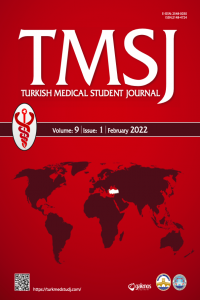EFFECTS OF ACUTE PHYSICAL EXERCISE AND ACUTE MENTAL EXERCISE ON SIMPLE VISUAL REACTION TIME
EFFECTS OF ACUTE PHYSICAL EXERCISE AND ACUTE MENTAL EXERCISE ON SIMPLE VISUAL REACTION TIME
Exercise, pulse, reaction time,
___
- 1. Hirsch A. Chronoscopic experiments on the speed of different senses and nerve transmission. Bulletin de la Société des Sciences de Neuchâtel 1862;6:100-14.
- 2. Nicolas S. On the speed of different senses and nerve transmission by Hirsch. Psychol Res 1997;59:261-8.
- 3. Donders FC. Die Schnelligkeit psychischer processe. Archiv für Anatomie, Physiologie und wissenschaftliche Medizin 1868;6:657- 81.
- 4. Exner S. Experimentelle untersuchung der einfachsten psychischen processe. Archiv ffir die gesammte Physiology des Menschen und der Thiere 1873;7:601-60.
- 5. Shelton J, Kumar GP. Comparison between auditory and visual simple reaction times. Neuroscience & Medicine 2010;1:30-2.
- 6. Miller JO, Low K. Motor processes in simple, go/no-go, and choice reaction time tasks: a psychophysiological analysis. Journal of Experimental Psychology: Human Perception and Performance 2001;27(2):266-89.
- 7. Brisswalter J, Arcelin R. Influence of physical exercise on simple reaction time: Effect of physical fitness. Perceptual and Motor Skills 1997;85:1019-27.
- 8. Tomporowski PD, Ellis NR. Effects of exercise on cognitive processes: a review. Psychological Bulletin 1986;99(3):338-46.
- 9. Tomporowski PD. Effects of acute bouts of exercise on cognition. Acta Psychologica 2003;12:297-324.
- 10. Kosinski RJ. A literature review on reaction time. 2005 (cited 2019 April 1) Available from: URL: https://homepage.univie.ac.at/andreas.franz.reichelt/intro2cogsci2/data/literature_review_reaction_time.pdf.
- 11. Brisswalter J, Collardeau M, Arcelin R. Effects of acute physical exercise characteristics on cognitive performance. Sports Med 2002;32(9):555-66.
- 12. Kahneman D. Mental Effort. Thinking, Fast and Slow. 1st ed. New York: Penguin; 2013.
- 13. R Core Team. R: A language and environment for statistical computing. R Foundation for Statistical Computing (online) (cited 2019 April 1): Available from: URL:https://www.R-project.org/.
- 14. Osorio, F. Robust estimation using heavy-tailed distributions. R package version 0.38.19 (online) (cited 2019 April 1): Available from: URL:https://CRAN.Rproject.org/package=heavy.
- 15. Luu C, Kalloniatis M. The perception of color. Webvision: The Organization of the Retina and Visual System (online) 2005 May 1 (cited 2019 April 1) Available from: URL: https://www.ncbi.nlm.nih. gov/books/NBK11538/.
- 16. Korenbrot JI. Speed, sensitivity, and stability of the light response in rod and cone photoreceptors: facts and models. Prog Retin Eye Res 2012;31(5):442–66.
- 17. Blizzard S, Fierro-Rojas A, Fallah M. Response inhibition is facilitated by a change to red over green in the stop signal paradigm. Front Hum Neurosci 2017;10:655.
- 8. Jain A, Bansal R, Kumar A et al. A comparative study of visual and auditory reaction times on the basis of gender and physical activity levels of medical first year students. Int J Appl Basic Med Res 2015;5(2): 124–7.
- 19. Wong AL, Goldsmith J, Forrence AD et al. Reaction times can reflect habits rather than computations. Elife 2017;6:e28075.
- 20. Badau D, Baydil B, Badau A. Differences among three measures of reaction time based on hand laterality in individual sports. Sports(Basel) 2018;6(2):45.
- 21. Darbutas T, Juodžbalienė V, Skurvydas A et al. Dependence of reaction time and movement speed on task complexity and age. Medicina(Kaunas) 2013;49(1):18-22.
- 22. Yagi Y, Coburn KL, Estes KM et al. Effects of aerobic exercise and gender on visual and auditory P300, reaction time, and accuracy. Eur J Appl Physiol Occup Physiol 1999;80(5):402-8.
- 23. Bhabhor MK, Vidja K, Bhanderi P et al. A comparative study of visual reaction time in table tennis players and healthy controls. Indian J Physiol Pharmacol 2013;57(4):439-2.
- 24. Ashnagar Z, Shadmehr A, Jalaei S. The effects of acute bout of cycling on auditory & visual reaction times. J Bodyw Mov Ther 2015;19(2):268-72.
- 25. Yerkes RM, Dodson JD. The relation of strength of stimulus to rapidity of habit-formation. J Comp Neurol Psychol 1908;18:459–82.
- 26. Duffy E. Activation. In: NS Greenfield, RA Sternbach, editors. Hand book of psychophysiology. New York;1972.p.577-622.
- 27. Levitt S, Gutin B. Multiple choice reaction time and movement time during physical exertion. Res Q 1971;42(4):405-10.
- 28. Sjoberg H. Relations between heart rate, reaction speed, and subjective effort at different workloads on a bicycle ergometer. Journal of Human Stress 1975;1:21-7.
- ISSN: 2148-4724
- Başlangıç: 2014
- Yayıncı: Trakya Üniversitesi
A NEWBORN WITH ESOPHAGEAL ATRESIA, TRACHEOESOPHAGEAL FISTULA AND FEEDING PROBLEMS
Arda Ulaş MUTLU, Oğuz KIZILKAYA, Mustafa İNAN
TORTICOLLIS SECONDARY TO A POSTERIOR FOSSA TUMOR: A CASE REPORT
Aslı GÖZTEPE, Mahmut Alper GÜLDAĞ, Ahmet Tolgay AKINCI, Mert ÇİFTDEMİR
Fatih Erkan ATAY, Begüm SÖYLEYİCİ, Alperen ELİBOL, Pelinsu Elif HÜNKAR, Berfin TAN, Volkan YÜKSEL
AWARENESS OF SYMPTOMS AND SIGNS IN SPONDYLOARTHRITIS AMONG FAMILY PHYSICIANS IN EDIRNE CITY CENTER
Hilal Sena ÇİFCİBAŞI, Berfin TAN, Aslı GÖZTEPE, Alperen Taha CERTEL, Ayşe ÇAYLAN, Barış YILMAZER
EFFECTS OF ACUTE PHYSICAL EXERCISE AND ACUTE MENTAL EXERCISE ON SIMPLE VISUAL REACTION TIME
Berkay Kef, Alperen Elibol, Ece Şenyiğit, Hasan Orkun İpsalalı, Umutcan Gölbaşı, Fatih Erkan Atay, Arda Ulaş Mutlu, Ekin Altınbaş, Hüseyin Karaman, Ceylin Eylül Karakaş, Ezgi GÜNEŞ, Aybüke Nazlı GÜLTEKİN, Enes TAŞÇI, Salim TURAN, Berk TOY, Oktay KAYA, Melike ŞAHİNER, Güldal İnan GÜLTEKİN
